| September
Cooking Classes |
Mon, Sep 29 - Gluten, Dairy & Soy Free
Baking with Laura Karasek
Harper's
Point from 6:30 - 9:00pm. $40 -
New date due to Wind Storm!
(Also offered Thu Oct 2 at Settlers' Walk)
Thu, Oct 2, 9, 16 -
Adult Basic Culinary Skills
Series
Three Class Series (Oct 2, 9,
16) with Greg
GenettiHarper's Point from 6:00 -
9:00pm. $215/3-class series For beginning and practiced cooks
who want to who want to develop basic culinary skills and gain
proficiency in the kitchen, this series will teach you the
essentials of great cooking!
Thu, Oct 2 - Gluten, Dairy & Soy Free Baking with Laura Karasek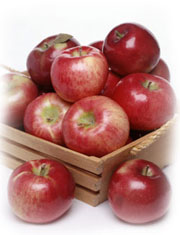
Settlers' Walk from 6:30 -
9:00pm. $40
(Also offered Mon, Sep 29 at Harper's
Point)
Tue, Oct 7 - Celebrate Apple Season with Matthew Hayden
Settlers' Walk from
6:30 - 9:00pm. $45
Thu, Oct 9 - Soups, Stews, and a Sweet with Bev Shaffer
Settlers' Walk from
6:30 - 9:00pm. $55
(Also offered Fri, Oct 10 at Harper's Point).
Fri, Oct 10 -
Soups, Stews, and a Sweet with Bev Shaffer
Harper's Point from
6:30 - 9:00pm. $55
(Also offered Thu, Oct 9 at Settlers'
Walk).
Tue, Oct 14 -
Haute Chocolate
with Lisa Cooper-Holmes
Harper's Point from 6:30 -
9:00pm. $45
Class
Full! Also offered Wed, Oct 15 at Settler's Walk.
Wed, Oct 15 -
Haute Chocolate
with Lisa Cooper-Holmes
Settlers' Walk from 6:30 -
9:00pm. $45
(Also offered Tue, Oct 14 at Harper's Point).
Wed, Oct 15 -
Autumn in Provence
with Marilyn Harris
Harper's Point from 6:30 -
9:00pm. $65
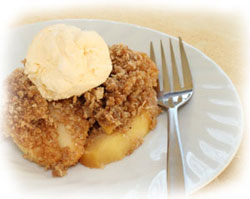 Thu, Oct 16
- Everyday Gourmet
with Edward Stanziano Thu, Oct 16
- Everyday Gourmet
with Edward Stanziano
Settlers' Walk from 6:30 -
9:00pm. $45
Sat, Oct 18 -
New Fall Apple Favorites with Leigh Ochs
Harper's Point from
11:00am - 1:30pm. $45
Sat, Oct 18 -
A Haunting Halloween Party for Ages 6-8 with Lorraine
Gose
Settlers' Walk from 11:00am -
1:00pm. $35
Mon, Oct 20 -
Appetizers by Chef Paul with Paul Dagenbach
Harper's Point from
6:30 - 9:00pm. $50
Class
Full! Also offered Mon, Nov 17 at Settler's Walk.
Thu, Oct 23 -
Eat Well's 'Goodies' from Scratch with Renee Schuler
Harper's Point from
6:30 - 9:00pm. $40
Thu, Oct 23 -
Meadowlark Salad Secrets
with Elizabeth Wiley
Settlers' Walk from 6:30 -
9:00pm. $40
Sat, Oct 25 -
Funny Holiday Treats for Ages 6-8 with Ruth Cammerer & Ann
Nofziger
Harper's Point 11:00am - 1:00pm.
$35
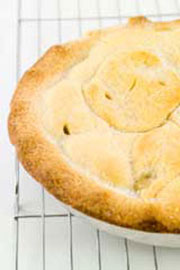 Sat, Oct 25
- Pies, Tarts and Turnovers Made Easy with Todd Davis Sat, Oct 25
- Pies, Tarts and Turnovers Made Easy with Todd Davis
Settlers' Walk from
12:00 noon - 2:30pm. $40
Mon, Oct 27 -
Classic Southern Cuisine with Damon Lee Fowler
Harper's Point from
6:30 - 9:00pm. $70
Tue, Oct 28 -
True Southern Hospitality with Damon Lee Fowler
Settlers' Walk from
6:30 - 9:00pm. $70
Tue, Oct 28 -
Perfect Pies with
Jessica Zimmerman & Michael Andresen
Harper's
Point from 6:30 - 9:00pm. $40
Wed, Oct 29 -
Time Saving, Energy Saving Cooking with Lori Cole
Harper's Point from
6:30 - 9:00pm. $35
(Also offered Thu, Oct 30 at Settlers'
Walk).
Thu, Oct 30 -
Time Saving, Energy Saving Cooking with Lori Cole
Settlers' Walk from
6:30 - 9:00pm. $35
(Also offered Wed, Oct 29 at Harper's
Point)
3 Ways to Register: On-Line, In
Store, or by Phone
Harper's Point classes - Call
513-489-6400 Settlers' Walk classes - Call
937-748-4540 10%
Discount on merchandise purchases on
the day you attend class! (excluding kitchen
electrics)
No Class Discount during Storewide
Sale. |
Grains of
Rice
|
 Understanding some basics about rice will allow
you to choose the best type for your recipe. With thousands
and thousands of rice varieties, it's no wonder that we're mystified
about what rice to use in which dish! Beyond the specific type
of rice, there's a list of adjectives for how rice is processed that
further complicates the matter, e.g., white, brown, parboiled,
converted, or instant. Understanding some basics about rice will allow
you to choose the best type for your recipe. With thousands
and thousands of rice varieties, it's no wonder that we're mystified
about what rice to use in which dish! Beyond the specific type
of rice, there's a list of adjectives for how rice is processed that
further complicates the matter, e.g., white, brown, parboiled,
converted, or instant.
Rice is roughly categorized by its
size and shape: long-grain, medium-grain, and short-grain.
Conveniently, the rice's size and shape also correlates with its
chemical composition. Rice has two primary starches, amylose and
amylopectin. Amylose consists of molecules that when moistened
and heated change, but stay relatively intact. In contrast,
amylopectin has a branching molecular structure that disintegrates
when cooked causing the edges of the rice grain to dissolve and the
surface to become rough and sticky.
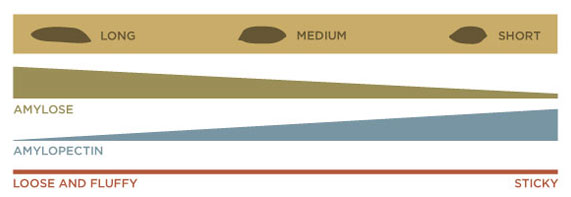
Long-grain rices have a higher amylose content than
amylopectin content; while short-grain rices have more amylopectin
and less amylose. Knowing this will allow you to predict how
the rice will react when cooked. Confused? Just remember,
"Long and loose, short and sticky."
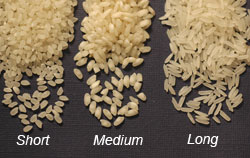 Long-grain rice - Long grain rice
is long and slender, four to five times longer than it is
wide. This type of rice has a higher amylose content than
amylopectin and cooks up as individual kernels, light and fluffy.
Use long-grain rice for pilafs and as a base for topping with other
foods. Long-grain varieties include: Basmati rice, Carolina rice,
Patna rice, Jasmine rice, Popcorn rice, and Pecan Rice. Long-grain rice - Long grain rice
is long and slender, four to five times longer than it is
wide. This type of rice has a higher amylose content than
amylopectin and cooks up as individual kernels, light and fluffy.
Use long-grain rice for pilafs and as a base for topping with other
foods. Long-grain varieties include: Basmati rice, Carolina rice,
Patna rice, Jasmine rice, Popcorn rice, and Pecan Rice.
Medium-grain rice - Medium-grain
rice is about two to three times longer than it is wide.
Medium-grain rices have more amylopectin starch than their
long-grain counterparts, and cook up with stickier kernels.
Examples of medium-grain rice include: Bomba, a Spanish rice
for paella, and Arborio, an Italian rice for risotto,
Short-grain rice - Short-grain rice
is generally less than twice as long as it is wide. Their
ovoid shapes are full of amylopectin and little amylose, and cook up
with an even stickier quality. Short-grain rice is best used
for puddings, molded presentations, sushi, or anywhere where its
stickiness is an advantage. In culinary practice, medium-grain and
short-grain rices are often lumped together and substituted one for
the other. Examples of short-grain rice include: Glutinous rice,
Mochi rice, Pearl rice, and Sushi rice.
How rice is processed
after its harvest impacts how it cooks and its culinary
application:
 Brown rice - Rice kernels
have three major layers: the hull or chaff, the bran, and the
inner kernel. Brown rice is rice that has had the hull
removed, but where the bran layer is intact. Long, medium, or
short-grain rices are each available as brown rice, though medium
and short-grain rices will be less sticky than their white
counterparts. Brown rice - Rice kernels
have three major layers: the hull or chaff, the bran, and the
inner kernel. Brown rice is rice that has had the hull
removed, but where the bran layer is intact. Long, medium, or
short-grain rices are each available as brown rice, though medium
and short-grain rices will be less sticky than their white
counterparts.
White
rice - White rice is processed further with both the outer
hull layer and the bran layer removed leaving just the inner kernel.
Similarly, long, medium, or short-grain varieties all exist as white
rice.
|
Remarkable Risotto
|
We have yet to
meet a risotto recipe that does not include the word "creamy" in its
description. Yet the creaminess is not from cream, but from a
suspension of the rice's starch in fragrant wine and sumptuous
stock.
 The basic ingredients for a risotto are few and
simple: a risotto rice, an onion, olive oil and butter, a little
wine, a great stock, a hard finishing cheese, and a patient
spoon. Choosing the right rice is essential; choose a
medium-grain rice that has a higher amylose content than long-grain
rice. Arborio rice is the classic choice for risotto.
Grown in the Po region of Italy, Arborio is readily available
everywhere. Lesser known Italian rices, Carnaroli, Maratelli,
Baldo, and Vialone Nano are also highly prized for risotto
making. The basic ingredients for a risotto are few and
simple: a risotto rice, an onion, olive oil and butter, a little
wine, a great stock, a hard finishing cheese, and a patient
spoon. Choosing the right rice is essential; choose a
medium-grain rice that has a higher amylose content than long-grain
rice. Arborio rice is the classic choice for risotto.
Grown in the Po region of Italy, Arborio is readily available
everywhere. Lesser known Italian rices, Carnaroli, Maratelli,
Baldo, and Vialone Nano are also highly prized for risotto
making.
Risotto recipes share the same basics
steps:
(1) Heat the stock in a nearby
saucepan and keep warm.
(2) Sauté the
finely diced onion in a little olive oil. Add the rice and
stir allowing each kernel to be coated in the oil. Briefly sauté
until the rice begins to have a translucent quality.
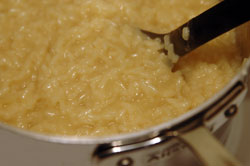
(3) Add the wine to the
rice mixture and gently cook until all of the wine has been
absorbed.
(4) Gradually add the warmed
stock to the rice using just a ladleful at a time. Keep the
heat at a moderate level and at a continuous bubble. Stir the
rice constantly. As the stock is absorbed, add the next ladle.
The finished rice should have an al dente consistency, like perfect
pasta.
(5) When all of the stock has been
absorbed, stir in the butter and finely grated cheese. Adjust
seasonings and serve.
With the basics mastered, risotto is
the perfect dish for improvisation! Use different medium-grain
rices, change the type of wine, substitute a different stock, and
accent with any number of flavors. The first recipe below is a
great risotto for practicing your skills. From there, try some
of these variations:
 Pesto - Add finely chopped fresh
basil and a diced tomato to the onion sauté. Use a dry white
wine and a chicken stock. Finish with Parmesan cheese and
toasted pine nuts Pesto - Add finely chopped fresh
basil and a diced tomato to the onion sauté. Use a dry white
wine and a chicken stock. Finish with Parmesan cheese and
toasted pine nuts
- Mushroom - Add a
variety of mushrooms, Shitake, Portobello, or Porcini, to the
onion sauté. Use a red wine and a beef stock. Finish with
Parmesan cheese and finely chopped parsley.
- Walnut - Sauté the
walnuts in butter, remove, then proceed with sautéing
shallots. Use a dry vermouth and a chicken stock.
Finish with a mix of Gorgonzola and Parmesan cheeses and the
sautéed walnuts.
- Artichoke and Lemon -
Use quartered artichoke hearts and lemon zest. Start with a
basic risotto preparation using a dry white wine and chicken
stock. Add the artichokes and lemon in the last few minutes
of cooking the rice. Finish with grated Romano cheese.
- Shrimp and Garlic -
Sauté onion adding minced garlic and small shrimp in the last 2
minutes. Remove the mixture from the pan and set aside while
the rice is cooking. Use a dry white wine with chicken
stock. With the last ladle of stock, add the onion, garlic and
shrimp. Finish with butter and Parmesan cheese.
- Fruity - Use semi-dry
red wine and chicken stock. Add dried cherries and golden
raisins with the rice allowing the dried fruit to absorb liquid
along with the rice. Finish with Brie or another triple
cream cheese.
- Green Risotto - Begin
with a basic risotto using vermouth and chicken stock. Puree
spinach, mint, and green peas together and add to the rice mixture
in the last few minutes of cooking. Finish with butter
and Parmesan
cheese.
|
Cooking Rice
Perfectly
|
 Three things need to align in order to achieve
perfectly cooked rice: (1) the right rice, (2) the ratio of
liquid to rice, and (3) the proper application of heat. The
first quick way to succeed in cooking rice is to choose the right
rice for the recipe by identifying the desired outcome. Does
the dish require fluffy rice with distinct grains, or sticky rice
where the grains hang together when cooked? The next step in
success is determining how much liquid to use. Generally,
long-grain rice requires 2 parts water to 1 part rice. But
this is where trouble begins, because different rice varieties have
different starch compositions and different absorption abilities.
Medium-grain rice requires 1.5 parts water to 1 part rice, and
short-grain rice demands 1.25 parts water to 1 part rice.
Vigilance and practice in cooking the same variety of rice will soon
give you the right proportion of water to grain. Many of the
methods for applying heat help to compensate for these
over-generalized water-to-rice ratios. Three things need to align in order to achieve
perfectly cooked rice: (1) the right rice, (2) the ratio of
liquid to rice, and (3) the proper application of heat. The
first quick way to succeed in cooking rice is to choose the right
rice for the recipe by identifying the desired outcome. Does
the dish require fluffy rice with distinct grains, or sticky rice
where the grains hang together when cooked? The next step in
success is determining how much liquid to use. Generally,
long-grain rice requires 2 parts water to 1 part rice. But
this is where trouble begins, because different rice varieties have
different starch compositions and different absorption abilities.
Medium-grain rice requires 1.5 parts water to 1 part rice, and
short-grain rice demands 1.25 parts water to 1 part rice.
Vigilance and practice in cooking the same variety of rice will soon
give you the right proportion of water to grain. Many of the
methods for applying heat help to compensate for these
over-generalized water-to-rice ratios.
 Stovetop - Combine the correct
proportions of liquid and rice in a saucepan and cover. Heat
to a boil, then reduce the heat to a simmer until all liquid is
absorbed. The time this takes will vary with the variety of
rice and the type of liquid used. Parboiled rice will cook more
quickly than regular rice. Stovetop - Combine the correct
proportions of liquid and rice in a saucepan and cover. Heat
to a boil, then reduce the heat to a simmer until all liquid is
absorbed. The time this takes will vary with the variety of
rice and the type of liquid used. Parboiled rice will cook more
quickly than regular rice.
Boiling - The boiling method of
rice is no fail, but reduces the nutritional value of the
rice. Place the rice in plenty of boiling water, just like
making pasta. Boil gently until the rice is al dente, or "just
tender." Drain the rice in a colander or sieve. Return the
rice to the hot pan and let rest for a couple minutes until any
excess water is absorbed by the rice.
 Rice Cookers - This method of
cooking rice guarantees success every time! If you enjoy rice
often, a rice cooker is a must. Rice and water is placed in
the inner vessel of the rice cooker. The rice cooker heats the
water, and "knows" when all of the water has been absorbed through
special sensors. Once this magic moment has arrived, the rice
cooker automatically shifts to a "warm" mode eliminating any
possibility of scorching or burning. Rice Cookers - This method of
cooking rice guarantees success every time! If you enjoy rice
often, a rice cooker is a must. Rice and water is placed in
the inner vessel of the rice cooker. The rice cooker heats the
water, and "knows" when all of the water has been absorbed through
special sensors. Once this magic moment has arrived, the rice
cooker automatically shifts to a "warm" mode eliminating any
possibility of scorching or burning.
Cooking Risotto - Making risotto
does not require a special pan, just a good one. One hazard of
risotto making is the possibility of rice sticking to the bottom of
the pan and potentially burning. A quality, heavy-bottomed pan
is essential. With a quality
pan, heat is efficiently
absorbed from the  heat source and
quickly transferred through its surfaces to the
food. A good saucepan
transfers heat evenly without
creating dangerous, (or frustrating), hot spots. heat source and
quickly transferred through its surfaces to the
food. A good saucepan
transfers heat evenly without
creating dangerous, (or frustrating), hot spots.
Baking Risotto - A great way to
make risotto without the manual effort of constant stirring is to
use cookware that is versatile on both the stovetop and in the
oven. Start the risotto in the traditional way, on the
stovetop. Instead of adding liquid by the ladleful, add all of
the liquid to the rice mixture, cover and bake in a medium oven
until all of the liquid is absorbed. Add the finishing butter
and cheese, stir, and return to the oven for an extra 5
minutes. It's not quite risotto, but not a bad
imitation. |
Smart
Rice-Making Tips
|
 Tip #1: Store rice in
a dry, airtight container free from changes in humidity. Buy
reasonable amounts of rice according to your use habits. Brown
rice with its bran layer will not keep as long as white rice; the
fats and oils present in the bran will degenerate more quickly than
white rice which has no bran. Cooked rice is best used within
2-3 days. Reheating rice, especially long-grain varieties will
require a tablespoon or two of liquid for each cup of leftover rice. Tip #1: Store rice in
a dry, airtight container free from changes in humidity. Buy
reasonable amounts of rice according to your use habits. Brown
rice with its bran layer will not keep as long as white rice; the
fats and oils present in the bran will degenerate more quickly than
white rice which has no bran. Cooked rice is best used within
2-3 days. Reheating rice, especially long-grain varieties will
require a tablespoon or two of liquid for each cup of leftover rice.
Tip #2: Use a
large saucepan for making risotto instead of a broad skillet.
This will minimize the evaporation of liquid allowing more of it to
be absorbed by the rice.
Tip
#3: When cooking, rice absorbs hot liquid and the
starches transform at their own rate. Microwaving rice does
not significantly reduce the cooking time of rice compared with a
stovetop preparation. |
Q & A
|
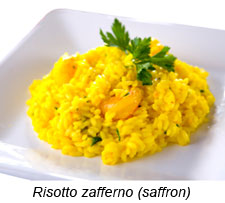  Q: What is the difference
between a rice pilaf and a risotto? Q: What is the difference
between a rice pilaf and a risotto?
A: A pilaf and a risotto are
similar in that the grain is first coated in oil or butter, and then
cooked in a vegetable or meat stock. However, with pilaf the
grain is browned in the oil and the end result is fluffier than with
risotto. Due to the type of rice used for risotto and the
cooking method, the outer starch layers dissolve into the wine and
stock forming a creamy suspension for the kernels.
Q: What is the difference between
rice described as parboiled, converted, polished, or
instant?
A:
Converted rice is the same as parboiled rice. Before the outer
hull is removed the rice grains are steamed, a process that
transfers some of the hull's nutrients to the kernel. The rice
is dried, then husked. Parboiled/converted rice tends to be
less sticky. The term polished rice is used generally for white
rice, or more specifically, for rice where the hull and bran layers
have been removed, and a portion of the inner kernel has been
"polished" away. Instant rice has been cooked, then
dehydrated. As the name implies, it cooks, actually
rehydrates, in just a few minutes.
 Q: What is wild
rice? Q: What is wild
rice?
A: Wild rice is not rice at
all, but rather seeds of certain types of aquatic grasses.
Wild rice is manually harvested from naturally
occurring locations in northern climates such as Minnesota and
Canada, or mechanically from cultivated fields.
Q: Should my rice be rinsed and
soaked before cooking?
A: You'll hear different
opinions on this topic. Domestic sources of rice will suggest
not rinsing or soaking. Rice in the U.S. is fortified with vitamins
much of which is washed away during rinsing. Aficionados will
insist that rinsing rice will return a cleaner taste. Soaking
rice for an hour allows the kernel to begin absorbing water.
Soaked rice will cook more quickly and leave the kernels more intact
and less sticky than unsoaked
rice. |
Cookbook
Review
|
The
Improvisational Cook by Sally Schneider. Published by
HarperCollins Publishers, New York, NY. Copyright 2006.
Nominated for the 2007 James Beard Cookbook Award.
 "There's no shortcut for
experience." This cookbook disproves that axiom! Truly unique
from typical cookbooks, Ms. Schneider turbo charges our culinary
knowledge base by imparting essential information about foods,
techniques, and pantries that empower us to try some ultimate "mix
and match" culinary experimentation without having to flirt with
failure. Ms. Schneider takes a topic and imparts key bits of
knowledge in "Understanding" sections that equip the cook with
what's important, and why things react and work well in different
situations. From there, several riffs are developed with a
curiosity and whimsy that lead to innovative results whether the
topic is risotto, onions, poultry, or breads. Through these
flights of improv we not only get to follow along, we witness,
firsthand, the thought pattern and the step-by-step process of
culinary creativity. By modeling improvisation, Ms. Schneider
teaches and allows us to fine tune our skills. If you've ever
admired a cook or hostess that just seems to instinctively know what
to do and consistently produces creative culinary combinations, this
book will leapfrog you into a similar
league. "There's no shortcut for
experience." This cookbook disproves that axiom! Truly unique
from typical cookbooks, Ms. Schneider turbo charges our culinary
knowledge base by imparting essential information about foods,
techniques, and pantries that empower us to try some ultimate "mix
and match" culinary experimentation without having to flirt with
failure. Ms. Schneider takes a topic and imparts key bits of
knowledge in "Understanding" sections that equip the cook with
what's important, and why things react and work well in different
situations. From there, several riffs are developed with a
curiosity and whimsy that lead to innovative results whether the
topic is risotto, onions, poultry, or breads. Through these
flights of improv we not only get to follow along, we witness,
firsthand, the thought pattern and the step-by-step process of
culinary creativity. By modeling improvisation, Ms. Schneider
teaches and allows us to fine tune our skills. If you've ever
admired a cook or hostess that just seems to instinctively know what
to do and consistently produces creative culinary combinations, this
book will leapfrog you into a similar
league. |
Recipes
|
Recipe reprinted with permission from
The
Improvisational Cook by Sally Schneider. Published by
HarperCollins Publisher, New York, NY. Copyright
2006.
 Risotto with Dry Sherry and
Lemon Risotto with Dry Sherry and
Lemon
The first bite of this risotto will leave
you without words and only some sort of combination of sighing and
purring. This variation is a great one to try if you've never
made a risotto. It's basic enough, yet flavored with
wonderfully simple flavors melded to perfection. We tried it
with some leftover Champagne (how did leftover Champagne happen?)
and it was an exquisite experience!
Click here to view the full
recipe.
Click here for a printable version of
the recipe.
 Warm Dessert Risotto with Bay Leaf and
Vanilla Warm Dessert Risotto with Bay Leaf and
Vanilla
With this recipe, Ms. Schneider gets us
in the improvisational mood. We found this preparation a
delightful dessert surpassing traditional rice puddings laden with
eggs and cream. We paired the serving with a peachy dessert
wine and a curled cookie.
Click here to view the full
recipe.
Click here for a printable version of
the recipe.
 Crispy Panfried Risotto
Cakes Crispy Panfried Risotto
Cakes
Leftover rice is always a bit of a
conundrum. With these cakes, we found ourselves making a
larger batch of risotto to ensure that we would have leftovers and a
next day treat of risotto cakes. Unlike other savory cakes, we
were taken with the crispy exterior and the creamy interior.
Risotto twice enjoyed!
Click here to view the full
recipe.
Click here for a printable version of
the recipe.
| |